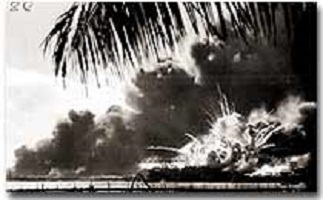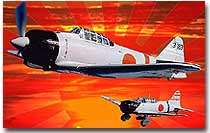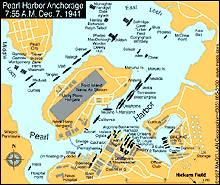50e. Pearl Harbor

The USS Shaw was damaged, but not destroyed, at Pearl Harbor. After repairs, it participated in convoy missions throughout the war and was decommissioned in 1945.
While the international picture in Europe was growing increasingly dimmer for the United States, relations with Japan were souring as well. Japan's aggression was literally being fueled by the United States. The Japanese military machine relied heavily on imports of American steel and oil to prosecute its assault on China and French Indochina.
Placing a strict embargo on Japan would have seemed obvious, but Roosevelt feared that Japan would strike at the resource-laden Dutch East Indies to make up the difference. Beginning in late-1940, the United States grew less patient with Japanese atrocities and began to restrict trade with the Empire.
Just prior to Hitler's invasion of the Soviet Union, Japan signed a nonaggression pact with Stalin. This removed the threat of a Russian attack on Japan's new holdings. With Europe busy fighting Hitler, the United States remained the only obstacle to the establishment of a huge Japanese empire spanning East Asia.
By the end of 1940, the United States had ended shipments of scrap metal, steel, and iron ore to Japan. Simultaneously, the United States began to send military hardware to Chiang Kai-shek, the nominal leader of the Chinese forces resisting Japanese takeover.

By the beginning of World War II, Japan had established a powerful navy aviation division. It was this superior air power that carried out the attack on Pearl Harbor.
Negotiations between Japan and the U.S. began in early 1941, but there was little movement. By midsummer, FDR made the fateful step of freezing all Japanese assets in the United States and ending shipments of oil to the island nation. Negotiations went nowhere. The United States was as unwilling to accept Japanese expansion and Japan was unwilling to end its conquests.
American diplomats did, however, have a hidden advantage. With the help of "Magic," a decoding device, the United States was able to decipher Japan's radio transmissions. Leaders in Washington knew that the deadline for diplomacy set by Japan's high command was November 25. When that date came and passed, American officials were poised for a strike. The prevailing view was that the attack would focus on British Malaya or the Dutch East Indies to replenish dwindling fuel supplies.
Unbeknown to the United States, a Japanese fleet of aircraft carriers stealthily steamed toward Hawaii.
The goals for the Japanese attack were simple. Japan did not hope to conquer the United States or even to force the abandonment of Hawaii with the attack on Pearl Harbor. The United States was too much of a threat to their newly acquired territories. With holdings in the Philippines, Guam, American Samoa, and other small islands, Japan was vulnerable to an American naval attack. A swift first strike against the bulk of the United States Pacific Fleet would seriously cripple the American ability to respond. The hopes were that Japan could capture the Philippines and American island holdings before the American navy could recuperate and retaliate. An impenetrable fortress would then stretch across the entire Pacific Rim. The United States, distracted by European events, would be forced to recognize the new order in East Asia.

On the morning of December 7, 1941, approximately 100 U.S. Navy battleships, destroyers, cruisers, and support ships, were present at Pearl Harbor.
All these assumptions were wrong. As the bombs rained on Pearl Harbor on the infamous morning of Sunday, December 7, 1941, almost 3,000 Americans were killed. Six battleships were destroyed or rendered unseaworthy, and most of the ground planes were ravaged as well. Americans reacted with surprise and anger.
Most American newspaper headlines had been focusing on European events, so the Japanese attack was a true blindside. When President Roosevelt addressed the Congress the next day and asked for a declaration of war, there was only one dissenting vote in either house of Congress. Despite two decades of regret over World War I and ostrichlike isolationism, the American people plunged headfirst into a destructive conflict.






